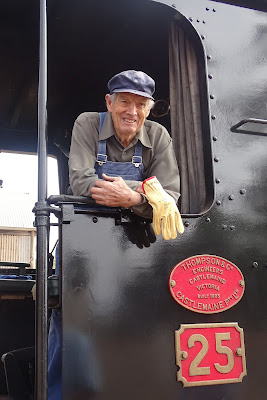2019 -
OZ 22 Quorn
Our
plan for today is to head North through Quorn and Hawker up to Blinman, (about
216 KM), then stay overnight and then take the 32 Km trip to Parachilna, kind of following the
old Ghan Tracks. And after all that back country driving, take
the Highway back to Quorn to stay another night in Quorn.
While
we were driving north towards Quorn, we got some history lessons from the locals
about this area. Quorn, the town, played
a major role in supplying the Middle of Australia with supplies. It was, years
ago, a larger town with lots of potential that faded away when the Railroad
tracks were rerouted, when the newly invented trucks took over from the trains.
I liked Quorn. When we arrived a film crew was filming some scenes involving
the Pichi Richi Railroad line, part of the old Ghan.
The Old Coal-Burning Ghan
Ah, Australia is so diverse, and to get from one end to the other the early settlers had to find ways to transport things over land.
While very early on the settlers used ships to get from harbor to harbor, it became more difficult when the interior had to be explored.
Ah, Australia is so diverse, and to get from one end to the other the early settlers had to find ways to transport things over land.
 |
| Pichi Richi Railroad Station |
While very early on the settlers used ships to get from harbor to harbor, it became more difficult when the interior had to be explored.
People
found spots in the interior that had water, had meadows and almost immediately started
farming, started raising cattle and or sheep. But the wool and the livestock
had to be transported somehow. An early solution was the use of camels as
transport. Of all the breeds of camels, the Afghan camel seemed ideal for the terrain
in Australia. So enterprising folks did not just import the camels from
Afghanistan; but also talked the handlers of those beasts, the camel drivers,
to come to Australia. Camels were the early trucks in Australia.
While the Rail Road transported the big loads, rail road tracks were expensive to lay and only limited lines were established due to the mountains that had to be crossed. The Pichi Richi was one of those original ‘tracks’ that supplied the new settlers but it later became part of the old Ghan line.
 |
| Interior of the Passenger Car |
While the Rail Road transported the big loads, rail road tracks were expensive to lay and only limited lines were established due to the mountains that had to be crossed. The Pichi Richi was one of those original ‘tracks’ that supplied the new settlers but it later became part of the old Ghan line.
And as you can see, the yellow line ‘used to be’ the Ghan, until it was rerouted to more populated spots in the interior of the Continent.
 |
| The Engineer |
The Ghan, an odd name, is shortened from AfGHANistan. Supplies for the inland towns had to be delivered by train and then the cameleers took over and distributed the shipments to the proper destinations. Remember there were no trucks at the time before 1900; and horses and oxen could not stand the heat of the desert, and they used way too much water to exist in this harsh climate. Supplies were shipped from the coastal towns to the interior via trains, but when the trains came back they were mostly empty, only a few ‘Ghans’, (Afghani men) were on the train. So the nickname for the train became the Ghan.
We were so enthralled by the history of this town Quorn, that we never made it past Hawker that day.
That did not mean we just hung around Quorn, but for Hawker and more of Quorn you have to read the next Blog.

No comments:
Post a Comment